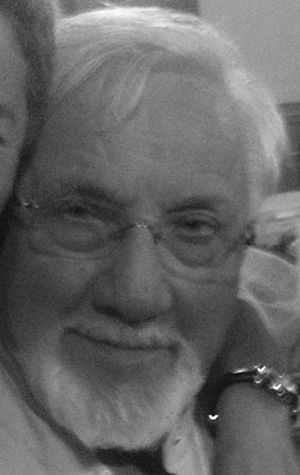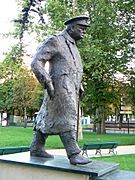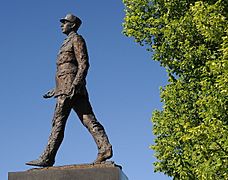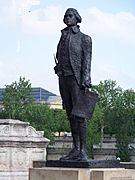Jean Cardot facts for kids
Quick facts for kids
Jean Cardot
|
|
|---|---|
 |
|
| Born | 20 July 1930 |
| Died | 13 October 2020 (aged 90) Paris, 14th arrondissement
|
| Nationality | French |
| Occupation | sculptor |
| Known for | member, president, Académie des Beaux-Arts |
|
Notable work
|
statues of Winston Churchill, Charles de Gaulle, Thomas Jefferson in Paris |
Jean Cardot (born July 20, 1930 – died October 13, 2020) was a famous French sculptor. He was born in Saint-Étienne, France. Jean Cardot was well-known for creating large sculptures, especially statues of important political leaders. His artworks were often designed to fit perfectly with the buildings or public spaces around them, like museums or town squares.
Contents
Becoming a Sculptor: Jean Cardot's Early Career
Jean Cardot began his art studies at a young age. From 1941 to 1956, he went to several important art schools in France. These included the School of Fine Arts in Saint-Étienne and Lyon. He also studied at the National School of Fine Arts in Paris. There, he learned from famous sculptors like Marcel Gaumont and Alfred Janniot.
In 1956, Jean Cardot won a special art award called the Grand Prix de Rome. This allowed him to live and work in Madrid, Spain, for two years. He stayed at the Casa de Velázquez from 1957 to 1959.
Teaching and Public Art Commissions
After returning to France, Cardot continued to gain recognition. In 1961, he won the Prix Antoine Bourdelle for sculpture. He also became a professor at the School of Fine Arts in Lyon. However, he left this teaching job in 1964 to focus completely on his own sculptures.
During this time, he started getting his first public art projects. These were commissions from the government or public organizations. In 1974, he became the head of a special sculpture workshop in Paris. This workshop focused on "direct chiseling," which means carving directly into raw materials. In 1989, he received another award, the Prix Paul Baudry.
Jean Cardot and the Académie des Beaux-Arts
Jean Cardot became a member of the Académie des Beaux-Arts on November 9, 1983. This is a very important group of artists in France. He was even chosen to be the president of the Académie twice, in 1992 and 1997.
Famous Sculptures and Public Works
Jean Cardot is known for creating large sculptures that fit well with their surroundings. In 1962, he made the "Madonna of Bouthéon" for a church in France. In 1967, he sculpted a bronze statue called "Dying Bull" for a high school. He also created a granite fountain sculpture for a hospital in Saint-Étienne in 1969.
One of his biggest projects was the "Monument to the Resistance and the Deportation" in Créteil. This large aluminum sculpture was chosen through a competition and put up in 1973-1975. In 1979, he made a sculpture of a flock of sheep. This artwork is displayed in front of the Cattenom nuclear power plant.
Statues of Important Political Figures
A major part of Jean Cardot's work involved creating huge statues of famous political leaders. These are some of his most well-known pieces:
- Sir Winston Churchill (1998): This statue of the former British Prime Minister is in Paris. It stands on the Right Bank of the Seine River, near the Petit Palais museum.
- General Charles de Gaulle (2000): Cardot also sculpted a statue of Charles de Gaulle, a famous French leader. This statue is on the Champs-Élysées in Paris, in front of the Grand Palais.
- Thomas Jefferson (2006): He created a statue of Thomas Jefferson, one of America's founding fathers. This statue is on the Left Bank of the Seine River in Paris. It faces the Musée d'Orsay.
Gallery
See also
 In Spanish: Jean Cardot para niños
In Spanish: Jean Cardot para niños






